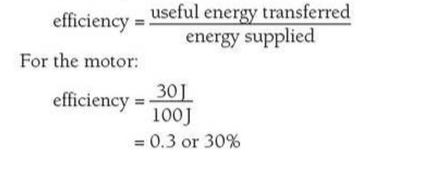

After studies on local discretization, the computational model undergoes a consistency check for model validation. Here, we present the measurement principles and procedures of creating the computational model of the CTEM. For a computational consistency check of the measuring principles, ideal conditions are assumed, while no potential error sources are implemented, yet. The computational thermal-electrical circuit model mainly consists of thermal sieving chains representing the relevant sample holder components, in particular two metallic blocks and a TE sample. As a solution approach of identifying possible error sources, a digital twin of the CTEM was developed. Currently, the measurement results show deviations due to unidentified error sources.
#Efficiency physics calculator full#
In this paper, we report on a computational model of the Combined ThermoElectric Measurement (CTEM) apparatus, which is a simultaneous characterization method capable of measuring the full set of above-mentioned thermoelectric transport properties between −190 and 600 ☌. The quantity zT is defined by the Seebeck coefficient ( S), the electric ( σ) and thermal ( κ) conductivity, and the absolute temperature ( T). The present study also includes the applications of the experimental power obtained from the setup of TEGs.Ī high thermoelectric (TE) figure of merit zT of materials enables a high energy conversion efficiency. This study presents TEGs experimental test to provide accurate TEGs performance data at the various range of temperature difference and design a heat dissipation setup for TEGs to analyse the efficiency obtained from heat dissipated in the exhaust. But both of TEG and heat pipe are durable and cost effective. TEGs have limitations, such as low temperature limits and relatively low efficiency, and heat pipes also have some limitations such as maximum rates of heat transfer and temperature limits. Heat pipes are used to reduce the thermal resistance in the system, as well as temperature regulation of the TEGs.


#Efficiency physics calculator generator#
Thermoelectric generators are an environment friendly source of electric power which make use of the Seebeck effect to convert a difference in temperature between hot and cold side of thermoelectric generator into electricity. To improve the efficiency of the engine indirectly by using a system to recover waste heat from the exhaust, the technology useful for this purpose is thermoelectric generators (TEGs). A majority of this energy is dissipated as heat in the exhaust which is about one-third of the total energy produced during combustion. The internal combustion engine (ICE) does not efficiently convert chemical energy into mechanical energy. In the future, this system hopefully could replace the car battery for charging the alternator as well as increasing the overall efficiency of the engine system. The further improvement of the system is currently under investigation for producing higher power. The early stage of finding reveals that the system was able to produce an open circuit voltage of 0.13 V for a small temperature gradient of 3ᵒC between the cold and hot surface of the TEG. The electrical power output was determined using the Seebeck principle. The theoretical model consisted of the heat transfer mechanism including the thermal resistance networks from the flue gas to TEG and the heat sink. A theoretical model was developed to access the thermal and electrical performance of the TEG system. A thermoelectric generator (TEG) consisted of thermoelectric modules, hexagonal pipe connector and heat sinks was built and connected to an exhaust pipeline. This research developed and investigated a heat recovery system using a thermoelectric generator (TEG) for power generation. The use of thermoelectric generator (TEG) for waste heat recovery and power generation could increase the efficiency of the internal combustion engine system. The automotive engine usually produces waste heat ranging from 30-40% due to the thermodynamic limit. Heat recovery technology using thermoelectric has attracted many research intentions mainly for its ability to generate power passively.


 0 kommentar(er)
0 kommentar(er)
